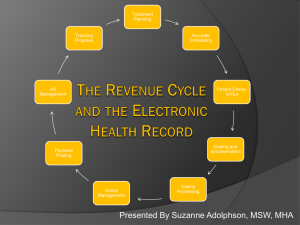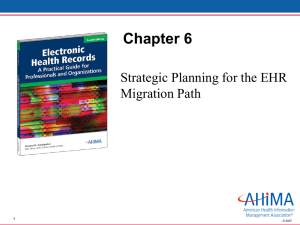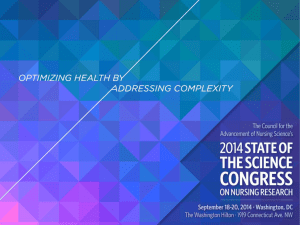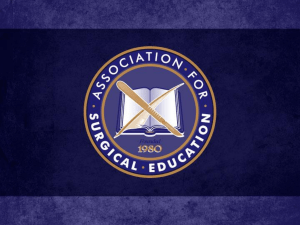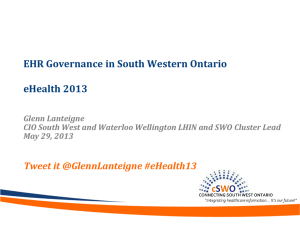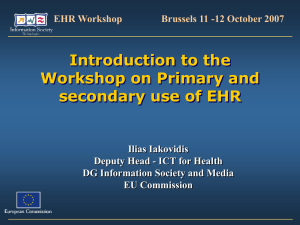Electronic Health Record and Clinical Research
advertisement
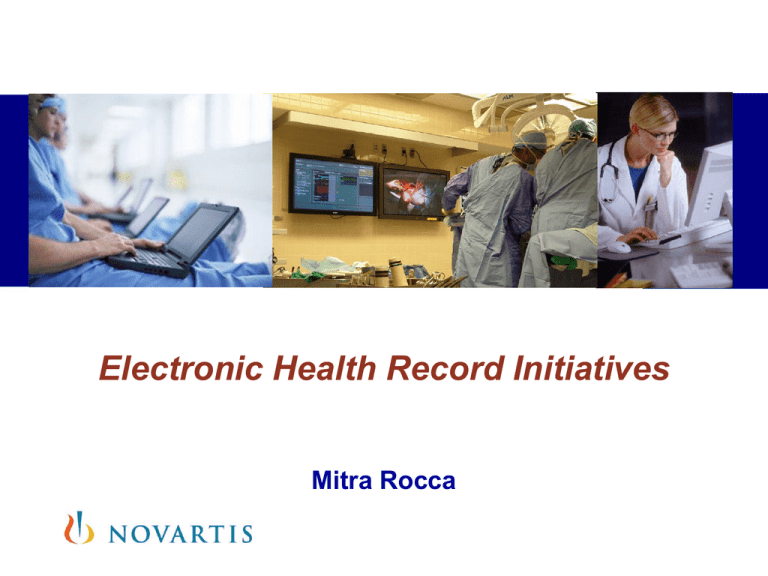
Electronic Health Record Initiatives Mitra Rocca Outline of the Presentation Health Record Terms and Definitions Current Status of Health Information Networks and Electronic Health Record (EHR) Systems • US • EU Role of EHR/Health Information Technology (HIT) in Clinical Research Ongoing EHR Initiatives 2 | EHR| 09 October 2008 | Presentation to PRIMS Forum Outline Health Records Terms and Definitions (EMR, EHR, PHR) Why Implement an EHR System? 3 | EHR| 09 October 2008 | Presentation to PRIMS Forum Electronic Medical Record (EMR) An electronic record of health-related information on an individual used by healthcare providers and residing within a system or organization. 4 | EHR| 09 October 2008 | Presentation to PRIMS Forum Electronic Health Record (EHR) CPOE: Computerized Physician Order Entry CDR: Clinical Data Repository CMV :Controlled Medical Vocabulary CDSS: Clinical Decision Support System Interoperability distinguishes EHR from EMR It’s ability to be shared across organizations. Documentation Interface Engine 5 | EHR| 09 October 2008 | Presentation to PRIMS Forum CMV* CDSS* Web Portal Interface Engine NHIN CDR* Pharmacy • Laboratory Enterprise Master Patient Index (EMPI) • Radiology CPOE* • PACS • Transcription Workflow • Departmental Systems • Pat. Access • Billing/Coding • HR • Scheduling • ERP • Resource Management EHR Environment NHIN Personal Health Record (PHR) Contains lifelong health information that is entered and owned by the patient, usually accessible over the Internet. 6 | EHR| 09 October 2008 | Presentation to PRIMS Forum Why implement an EHR System? Improves Performance (Safety, Quality) Clinical Decision Support Reduces undesirable variation Increases Efficiency Reduces transcription, redundant tests Facilitates Data Reporting Enhances Value Pay for Performance Safety 7 | EHR| 09 October 2008 | Presentation to PRIMS Forum Outline US Landscape Current Status of the Nationwide Health Information Network (NHIN) 8 | EHR| 09 October 2008 | Presentation to PRIMS Forum US: Office of the National Coordinator (ONC) for HIT American Health Information Community (AHIC) Executive Order Most Americans to have an EHR by 2014… President Bush Four Goals of ONC Strategic Framework 1.Inform clinical practice 3. Personalize care • Incentivize EHR adoption • Encourage use of PHRs 2.Interconnect clinicians 4. Improve population health • Unify public health surveillance • Develop a nationwide health information network architecture American Health Information Community (AHIC) Provide Recommendation to public and private sectors to accelerate HIT AHIC Members: Public Sector (CDC, VA, DoD, NIST, …) Private Sector (Intel, …) Non-for-Profit Organizations (National Patient Advocate Foundation, …) 9 | EHR| 09 October 2008 | Presentation to PRIMS Forum American Health Information Community (AHIC) Ongoing Projects Workgroups: 1. 2. 3. 4. 5. 6. 7. Chronic Care Confidentiality, Privacy and Security Consumer Empowerment EHR Personalized Healthcare Population Health Quality Main Contracts: Standards Harmonization – Health IT Standards Panel (HITSP) EHR, IT Infrastructure Certification – Certification Commission for HIT Over 100 EHR systems certified as of Jan. 2008 Nationwide Health Information Network (NHIN) pilots Security and Privacy Policies 10 | EHR| 09 October 2008 | Presentation to PRIMS Forum Why are these national efforts important to Biopharmaceutical industry? Investigate the Pharma-specific use cases that could leverage Health Information Exchanges (HIE) and the Nationwide Health Information Network (NHIN) Improve development, administration, safety and surveillance of drugs and medical products Define the obstacles and key enablers to the pharmaceutical industry realizing the benefits of this emerging infrastructure Legal and Policy Standards Data Ownership Financial Technical 11 | EHR| 09 October 2008 | Presentation to PRIMS Forum NHIN Significance to Pharma: The NHIN Slipstream Project Why: • Pharma can help to define the key HIT use cases for enabling clinical research and monitoring the safety and effectiveness of medicines • Assessment that the Pharma industry would have greater impact if it were able to speak with a unified voice in national, regional, and local HIT efforts Who: • 4 pharmaceutical companies: AstraZeneca, Bristol-Myers Squibb, Pfizer, and Wyeth What: • List of use cases relevant to Pharma, prioritized down to the top three • Three detailed use cases, including value propositions and proof of 09concept opportunities 12 | EHR| October 2008 | Presentation to PRIMS Forum Slipstream Use Cases: The Pharmaceutical value chain and priority Use Cases Clinical Research 1. Genetic Clinical Development 3. Clinical Trial Association and Linkage Analysis 10. Post- Execution 2. Clinical Validation – Target, Biomarker, and Diagnostic Regulatory / Safety Marketing a. Connect Patients to Trials b. Data Collection & Mgmt c. Investigator Services d. Compliance e. Placebo Populations a. Safety / Adverse Event Monitoring b. Pharmacovigilance c. P-Epi & Data Mining Prioritized High-Level Use Cases 4. Clinical Trial Simulation11. Manufacturer’s 5. New Indication Identification 6. Interim analyses Recall Commercial 12. Pharmacoeconomics 13. Marketing Comparative Studies 14. Pharmaceutical/ Disease Management Programs 15. e-Prescribing 7. Personalized Medicine – Pharmacogenomics 8. Outcomes Studies 13 | EHR| 09 October 2008 | Presentation to PRIMS Forum 9. Disease and Care Management Modeling EU eHealth IT Initiatives: 2005-2010 Health Information Network Connecting for Health (UK) Elektronische Gesundheitskarte National Institute for ICT in Health (NICTIZ) 14 | EHR| 09 October 2008 | Presentation to PRIMS Forum Deliver better, safer care to patients, via new computer systems and services, that link GPs and community services to hospitals Electronic health cards which will eventually contain the patients' complete health history in digital format The National IT Institute for Healthcare in the Netherlands - is the national coordination point and knowledge centre for IT and innovation in the healthcare sector. Health Information Networks: Canada Health Infoway Independent, not-for-profit organization, Members from Canada's 14 federal, provincial and territorial Deputy Ministers of Health. Canada Health Infoway’s 2007-09 Corporate Business Plan focuses on accelerating the implementation of electronic records across Canada. $1.6 Billion of investment capital Goal: 50% of Canadians will have Interoperable Electronic Health Records (iEHR) by 2010 15 | EHR| 09 October 2008 | Presentation to PRIMS Forum Outline Role of EHR/HIT in Clinical Research Why are EHRs important for Clinical Research? 16 | EHR| 09 October 2008 | Presentation to PRIMS Forum Clinical Care and Clinical Research 2 separate “electronic” worlds…. Technology GP’s Office GP’s Office Data standards GP’s Office GP’s Office Semantics Pharma Industry Quality & completeness of data Pharma Industry Hospital Hospital GP’s Office GP’s Office GP’s Office Hospital Hospital Governance structures & processes GP’s Office 17 | EHR| 09 October 2008 | Presentation to PRIMS Forum Pharma Industry Clinical Care and Clinical Research .. That could interoperate Study Setup GP’s Office GP’s Office Patient recruitment GP’s Office GP’s Office Electronic data capture Submission and Reporting Pharma Industry Hospital Hospital Pharmacovigilance GP’s Office Pharmaco-economics Pharma Industry GP’s Office ePrescribing GP’s Office Hospital Hospital GP’s Office Predictive safety Pharma Industry Pharmaceutical/disease management 18 | EHR| 09 October 2008 | Presentation to PRIMS Forum Why are EHRs important for Clinical Research? Trial Step EHR potential role Study Setup Query EHR database to establish number of potential study candidates. (Protocol Feasibility) Incorporate study manual or special instructions into EHR “clinical content” for study encounters Patient Implement study screening parameters into patient Recruitment registration and scheduling. Query EHR database to contact/recruit potential subjects and notify the patient’s healthcare provider(s) of potential study eligibility. 19 | EHR| 09 October 2008 | Presentation to PRIMS Forum Why are EHRs important for Clinical Research? Trial Step EHR potential role Study Incorporate study-specific data capture as part of routine Execution clinical care / clinical documentation workflows Auto-populate study data elements into case report forms (Merging from other parts of the EHR database. EHR & EDC) Embed study-specific data requirements (case report forms) as special tabs/documentation templates using structured data entry. Implement rules/alerts to ensure compliance with study data collection requirements Create range checks and structured documentation checks to ensure valid data entry 20 | EHR| 09 October 2008 | Presentation to PRIMS Forum Why are EHRs important for Clinical Research? Trial Step EHR potential role Submission Document and report adverse events & Reporting Risk management plan requirements (FDA) Evidence based Implement study findings as clinical documentation, clinical care Monitor changes in care and outcomes in response to orders sets, point-of-care rules/alerts evidence-based clinical decision support Provide easy access to detailed clinical care data for motivating new clinical trial hypotheses 21 | EHR| 09 October 2008 | Presentation to PRIMS Forum EHR-Clinical Research Ongoing Projects 22 | EHR| 09 October 2008 | Presentation to PRIMS Forum HIMSS 2007 / IHE Five Life Sciences Use Cases Drug Safety (Pfizer, AllScripts) Physician investigator, using an EHR, discovers a suspected adverse drug event and summons a data-capture form from the drug manufacturer to provide information on the event. Clinical Trial Implementation (Eli Lilly, Cerner) A physician investigator, using an EHR, summons a clinical research data capture form from an EDC, establishes context, then fires off an EDC session for further data capture. Local Labs and Images (Novartis, Siemens) Clinical Investigator schedules, reviews, and submits clinical trial lab results and images to directly to Novartis via internet Disease Registry (Genzyme) EHR user completes a guest form for disease registry. Biosurveillance (Centers for Disease Control and Prevention) A physician using an EHR discovers a suspected outbreak of a disease. Using RFD, the physician summons a data-capture form from CDC, completes the form, and returns. 23 | EHR| 09 October 2008 | Presentation to PRIMS Forum EHR/EDC - Integration – HIMSS 2007 Novartis Received Status Alerts Completed Data Start Novartis Protocol Visit Schedule with Detailed Data Elements Approved CDISC RFD or HL7 Message EDC/EHR Integration Vision Investigator & Novartis is notified what is scheduled/completed HL7 Standards Based HL7 CDISC/IHE - RFD DICOM LOINC RDF or HL7 Message DICOM Workflow is updated & Novartis is notified what is/not completed HL7 LOINC HL7 Integrated EHR Data Collected as per Health Record work flow stored for System investigator review Labs process order 24 | EHR| 09 October 2008 | Presentation to PRIMS Forum Novartis Research Server generates eCRF and/or Visit Schedule using CDISC RFD or HL7 message EHR Vendor receives Novartis information & Creates EHR Workflow Investigator identifies patient in the Clinical Trial & Visit Schedule workflow creates orders for Labs & PET/CT (Radiology) etc. PET/CT Scanner a component of PACS/RIS Radiologist to review PET/CT Scan images EHR Clinical Research Project Vision “Roadmap” to Connect Healthcare and Clinical Research 25 | EHR| 09 October 2008 | Presentation to PRIMS Forum 25 Project Sponsors & Participants Sponsors: Global Participants: • Bayer • Boehringer Ingelheim EDC/eSource Task Group • Bristol Myers Squib • Cerner Corporation In Cooperation With: HL7 EHR & RCRIM Workgroups CDISC • ClinPhone Inc. • Eli Lilly and Company * • FDA • Glaxo SmithKline • Hoffman La Roche • Lundbeck • Millennium • National Cancer Institute • Northrop Grumman • Novartis • Pfizer * 26 | EHR| 09 October 2008 | Presentation to PRIMS Forum • Procter & Gamble * EHR CR Project Overview Develop a Global EHR/Clinical Research Functional Profile (EHR/CR-FP) Identify critical requirements for clinical research utilizing EHR systems through: • Expansion of the HL7 EHR FM R1 to include clinical research requirements • Mapping to EuroRec EHR Requirements Repository and identifing Clinical Research-specific requirements • Providing the profile to both CCHIT and EUROREC Outcomes: EHR Vendors: provide with requirements for incorporating clinical research functions into their systems Sponsors: provide basis for evaluating EHR systems as source data systems 27 | EHR| 09 October 2008 | Presentation to PRIMS Forum 27 HL7 EHR Clinical Research Status HL7 EHR Clinical Research Functional Profile passed the HL7 May 2008 ballot cycle Conducted a proof-of-concept assessment of a large EHR system (Cerner Millennium) against our requirements/profile, results assisted us with profile reconciliation and stakeholder awareness Currently mapping user requirements to EuroRec Formed a CCHIT roadmap planning committee 28 | EHR| 09 October 2008 | Presentation to PRIMS Forum 28 HL7 EHR/CR Functional Profile Example New Conformance Criteria for Clinical Research IN 1.1.1 User Authentication Statement: Authenticate EHR-S users before allowing access to an EHR-S. 1. The system SHALL prevent access to EHR-S applications or EHR-S data to all non-authenticated principals 2. The system SHALL prevent access to EHR-S applications or EHR-S data to all non-authenticated principals 3. The system SHALL limit the number of log-in attempts and record failed log-in attempts 4. IF username/password is used, the system SHALL allow and enforce password to be changed at established intervals 29 | EHR| 09 October 2008 | Presentation to PRIMS Forum EU EHR Clinical Research Profile Approach Global Clinical Research User Requirements… User Requirement Tier 1 (Core) Relevance International International Regs Regulations System and Data Security Requirements HL7 EHR CR Functional Profile Conformance Criteria System shall have an audit trail to include recording date/time/author of any data creation, change, or deletion … and reason … Regulatory Link CSUCI: D2b, D2c, D2f, D2g Part 11: 11.10 e Essential Optional (future) ICH GCP: 4.9.3, 5.5.4 21 CFR: 312.62 …Mapped to Existing Criteria Conformance Criteria EuroRec Conformance Criteria GS002183.02 The audit log contains create/edit/ deleted events. HL7 Shall provide the ability… GS002188.01 Audit log records include date and time of recordable events. Should provide the ability GS002191.01 An audit log record includes the user identity associated with a recorded event. May provide the ability … 30 | EHR| 09 October 2008 | Presentation to PRIMS Forum EuroRec Fine Grained Statements …New Criteria Needed to Meet Clinical Research Needs GS002192.01 An audit log record contains the outcome status of a recorded event. GS003652.01 The system registers in an audit log what has been accessed by the patient when consulting his/her own EHR. 30 Objective Create a Clinical Research Functional Profile based upon EuroRec EHR criteria By… Drawing upon… • EHR/CR user requirements • HL7 EHR/CR Functional Profile Standard • EuroRec EHR criteria to identify potential candidates for mapping to EHR/CR user requirements • EuroRec EHR labelling proposal Delivering • A submission of a proposed functional profile and a proposal for use to EuroRec for “standards” acceptance 31 | EHR| 09 October 2008 | Presentation to PRIMS Forum 31 Mapping in Progress Categories of Relevance Core – must have to meet minimum requirements Future – future need or nice to have Maybe – needs discussion Not relevant – not relevent now or ever New – a new criteria being proposed by EHRCR to meet Clinical Research User Requirements 32 | EHR| 09 October 2008 | Presentation to PRIMS Forum 13-Apr-15 Copyright EHR/CR Project 2007 32 Next Steps 1. Publish the HL7 EHR CR as an Informative Standard 2. Resubmit for Normative Standard after CDISC CDASH R1 standard is finalized 3. Identify services based on the HL7 EHR Clinical Research requirements: • Authorization • Consent management • Authentication • Clinical Decision Support • Verify Inclusion/Exclusion Criteria 33 | EHR| 09 October 2008 | Presentation to PRIMS Forum 33 CCHIT & Clinical Research Created a multi-stakeholder planning committee (Single Voice of the clinical research community), in order to get on the Certification Commission for Health Information Technology (CCHIT) Roadmap Participation by Academic Medical Centers clinical informatics researchers helps strengthen our case and provide a broader base. 34 | EHR| 09 October 2008 | Presentation to PRIMS Forum 34 CCHIT EHR CR Planning Committee Members • eClinical Forum EHR CR Team Members • Biopharmaceutical Industry • PhRMA (Pharmaceutical Research and Manufacturer of America) • EHR Vendors • FDA • NCI • HIMSS LifeSciences Roundtable • HL7 • CDISC • AMIA Clinical Research Informatics Workgroup • AHIMA • CCHIT • Clinical and Translational Science Awards (CTSA) 35 | EHR| 09 October 2008 | Presentation to PRIMS Forum 35 American Health Information Technology (AHIC) • Met on July 29th, 2008 • Panel on Supplemental Priority Development Pathway for Clinical Research Applications of Electronic Health Information - Gregory Downing, ONC - Rebecca Kush, CDISC - Kenneth Buetow, NCI - Greg Simon, FasterCures - Amy Miller, Personalized Medicine Coalition • AHIC to authorize exploration of a “supplemental” pathway to use case development, standards harmonization, and support interoperability of electronic health information to support clinical research information needs 36 | EHR| 09 October 2008 | Presentation to PRIMS Forum 36 Global EHR initiatives/activities (EFPIA EHR Taskforce) Build a common understanding of EHR and potential challenges for clinical research (EU focus) Define EFPIA consolidated position related to EHR and identify critical use cases to push forward Collaborate with • European Commission in the context of eHealth initiative Support/push data standardization activities related to EHR in clinical care in Europe Build business case: why would we invest into EHR integration ? 37 | EHR| 09 October 2008 | Presentation to PRIMS Forum eHealth Workstream Initiatives within PhRMA Vision: Collaborate within PhRMA to raise awareness and explore opportunities for eHealth in focused areas including: - integration with Clinical Research - improvement of drug safety capabilities - to enable clinical decision support - improved drug selection/prescribing Published a White Paper on HIT Ongoing Inititiatives: HIT Portfolio:Captures HIT related initiatives aimed at optimizing clinical research design and conduct PhRMA White paper on HIT HIT Monitoring Sources: HIT Bills, ListServs, NHINWatch, Meetings, Membership to various healthcare informatics associations, SDOs 38 | EHR| 09 October 2008 | Presentation to PRIMS Forum Key Messages EHR systems have capabilities that facilitate data capture and trial monitoring Clinical research should share health care data standards where possible There are many different data standards in Health Care but HL7 is emerging as the “de facto” world wide standard Integrating EHR data requires semantic interoperability (i.e. same meaning of data) between EHR systems and clinical research systems 39 | EHR| 09 October 2008 | Presentation to PRIMS Forum Thank you! Questions? Mitra Rocca Mitra.Rocca@novartis.com 40 | EHR| 09 October 2008 | Presentation to PRIMS Forum 40 Backup Slides 41 | EHR| 09 October 2008 | Presentation to PRIMS Forum Novartis Initiative: Clinical B2B Hub Proof-of-Concept Project Imaging Partner Personal Medical Device Partner EHR Partner HL7 XML HL7 Internet B2B HUB NOVARTIS Canonical Enterprise Service Bus Canonical NOVDD CT4 42 | EHR| 09 October 2008 | Presentation to PRIMS Forum Canonical Any Format Any System Purpose of DAM for Business Domain Experts Systematically analyze common data required by the Novartis business across business processes and clinical trials, and promote consistency with/extend evolving industry data models (BRIDG etc.) Bridge the gap between the clinical research and the healthcare domain, in order to exchange information externally with electronic health record systems Agree on common data elements, based on standard terminologies or vocabularies where appropriate (Ex: SNOMED, LOINC, …) to be used across applications 43 | EHR| 09 October 2008 | Presentation to PRIMS Forum Developing the Novartis DAM 1. Develop Content (clinical domain) Data submission 2. Create Storyboards and validate with Domain Experts Use Case Model Storyboard Use Case 7. Design Class Diagrams, Interaction Diagrams BRIDG Model SB 5. Identify classes that can be re-used from BRIDG Activity Diagram 8. MDR Data Entry Specification 3. Design AD and Validate them with Domain Experts 6. Model New Concepts 4. Conduct Gap Analysis Harmonization DE_AM New Concepts Modeling Class Diagram Interaction Diagram 44 | EHR| 09 October 2008 | Presentation to PRIMS Forum MDR DE_DE 9. Extend DE_DE implementation guide 10. Harmonize With BRIDG and Provide recommendatio ns Refine SOPs Outline Role of Standards and Interoperability in Integration of EHR and Clinical Research 45 | EHR| 09 October 2008 | Presentation to PRIMS Forum Role of Standards in Health Information Networks EHR Enterprise Portal HIS CDISC Data W/H Hospital Pharmaceutical CDISC & HL7 Lab HL7 Radiology DICOM HL7 Health Information Network NCPDP HL7 X12 Federal / State Government X12 Health Plan Pharmacy 46 | EHR| 09 October Primary Care 2008 | Presentation to PRIMS Forum Physician X12 Employer


